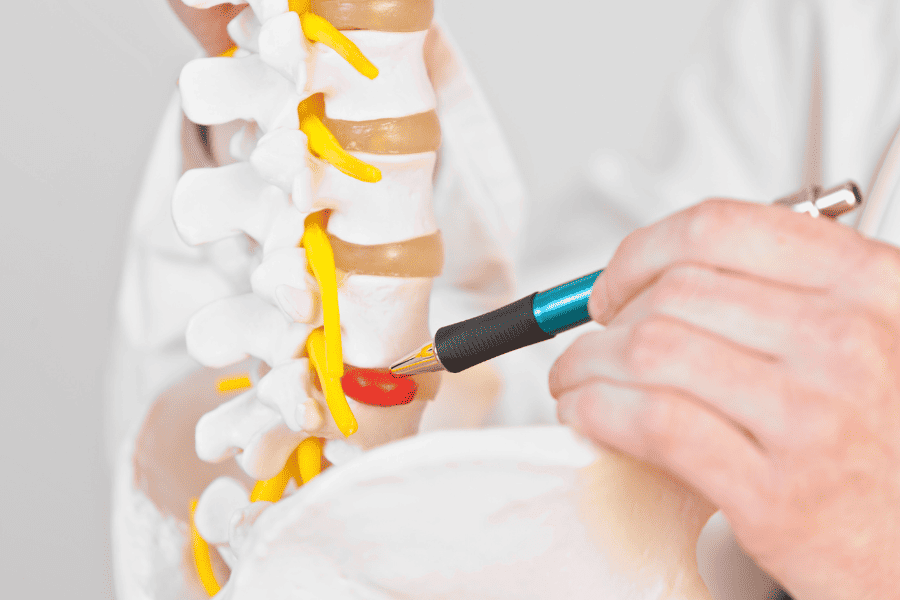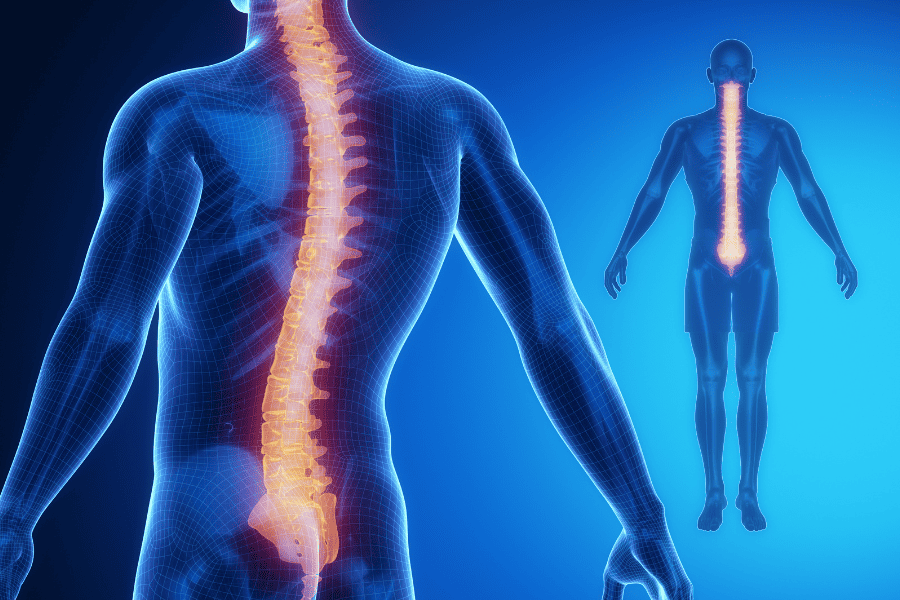What is a Herniated Disc?
 The spinal column comprises multiple interconnected discs, as seen in images or X-rays. Upon closer inspection, these discs appear stacked on top of each other. To better visualize a disc, imagine a jelly donut. It comprises a soft, central portion surrounded by a tougher outer layer.
The spinal column comprises multiple interconnected discs, as seen in images or X-rays. Upon closer inspection, these discs appear stacked on top of each other. To better visualize a disc, imagine a jelly donut. It comprises a soft, central portion surrounded by a tougher outer layer.
A spinal disc possesses a similar structure. The inner part, resembling jelly, functions as a cushion, offering protection. However, in the case of a herniated disc, this soft interior protrudes through the outer layer, akin to jelly escaping from the center of a donut.
Most herniated discs occur in the lower back, although they can also occur in your neck (cervical spine). Many people have no apparent symptoms associated with a herniated disc. But, as the disc begins to pressure a nerve, there can be any number of symptoms.
Several potential symptoms of a herniated disc include:
- Lower back pain
- Radiating pain from the hip to the leg, extending all the way to the ankle or foot (sciatica)
- Numbness or tingling sensation in one leg
- Muscle spasms or intense muscular discomfort
- Weakness in one or both legs
If you have been experiencing discomfort for several weeks and suspect you are suffering from this condition, contact Dr. Sadrameli’s office for diagnosis and treatment options.
What Causes a Herniated Disc?
 A herniated disc occurs when a spinal disc loses elasticity and ruptures, expanding beyond its intended boundary. A herniated disc is most often a result of gradual age-related wear and tear, commonly called disc degeneration.
A herniated disc occurs when a spinal disc loses elasticity and ruptures, expanding beyond its intended boundary. A herniated disc is most often a result of gradual age-related wear and tear, commonly called disc degeneration.
This means the disc(s) lose some water content (jelly), thus losing flexibility, and are more likely to tear or rupture – even under little pressure. Most of the time, people do not know precisely when the disc became damaged.
For some, herniated discs occur with improper lifting or twisting of the back when lifting an object. Very rarely, a herniated disc can result from a traumatic event like a fall.
Who is a Candidate for Herniated Disc Surgery?
Candidates for herniated discs typically have ongoing lower back pain, numbness, tingling, or pain in one leg, and/or muscle spasms. Your surgeon may suggest surgery if conservative treatment methods – such as therapy, medications, injections, and rest – fail to improve symptoms after six weeks.
Surgical Treatment to Repair Herniated Discs
In most cases, surgical treatment to repair herniated discs involves removing the protruding portion of the disc. While open or minimally invasive tubular microdiscectomy has been the standard of care, spinal endoscopy can offer an ultra-minimally invasive solution for patients with sciatica. This can be done through an 8mm incision and at times can save patients from undergoing spinal fusion. Patients undergoing spinal endoscopy can typically expect to be out of the hospital 2 hours after surgery.
Advantages of Ultra Minimally Invasive Endoscopic Discectomy:

- Immediate improvement of symptoms and quick discharge from the surgical facility
- Minor blood loss
- Minimal postoperative pain that does not require narcotic use — most patients treat their surgical pain with Tylenol, Robaxin and Gabapentin.
- Expeditious return to normal activity and work — typically within 72 hours
- Very low risk of infection or wound complication (0.001%)
Find Out More About Ultra Minimally Invasive Treatment for Herniated Discs
Request an appointment to find out if spine surgery at Orlando Neurosurgery is right for you. Your neurosurgeon will be able to properly diagnose your pain and discuss the benefits and risks associated with treating your spine pain.
Sign Up for Our Newsletter
Get the latest news and updates from Orlando Neurosurgery delivered straight to your inbox.


